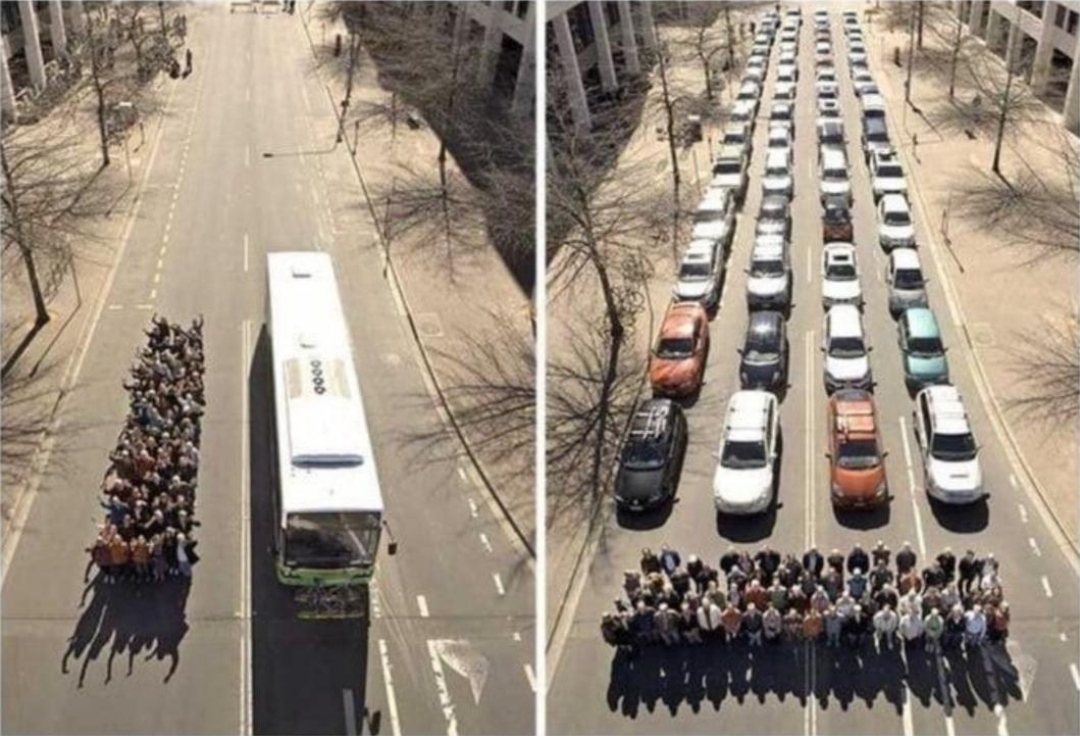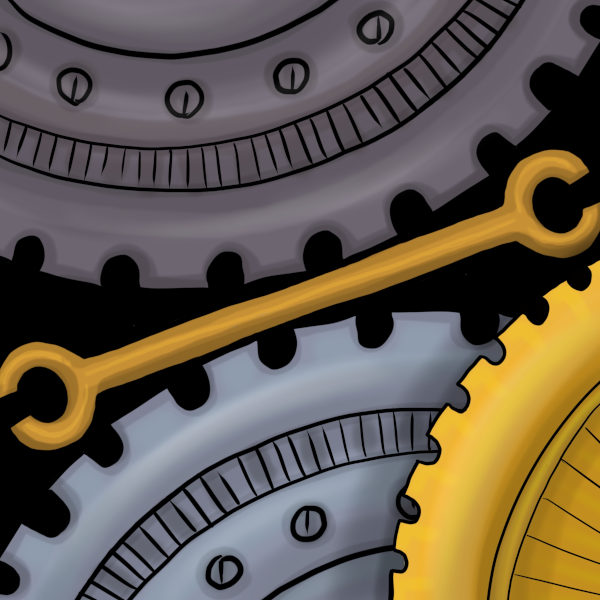- cross-posted to:
- fuck_cars@lemmy.ml
- tech@kbin.social
- cross-posted to:
- fuck_cars@lemmy.ml
- tech@kbin.social
Uber was supposed to help traffic. It didn’t. Robotaxis will be even worse::px-captcha
deleted by creator
mixed use spaces that allow people to walk to stuff.
They are real game changers!
Nah, bro. We need wider streets and more cars. That will surely reduce traffic.
Just one more lane, bro. I swear we’re going to fix traffic this time. Just one more.
Correct. Keep on increasing the road to building ratio of cities. Make the streets 500 m wide if you have to. This way there will be so much road and all the buildings will be so far apart that it’s impossible to have traffic jams.
Actually good trains and bus systems, actually good bike infrastructure, mixed use spaces that allow people to walk to stuff.
You forgot the single biggest factor: quit mandating low density. In order for walkability to happen, more trip origins and destinations need to be closer together.
Exactly. In my first time in the US I would spend weeks astonished by the terrible use of land they make of it. Then I discovered businesses were forced by law to build these stupidly large parking lots.
Seems like they thought that ride-sharing an Uber would reduce traffic, but the cheaper prices just ended up with more people using ride-hailing services instead of public transport.
Full article text: ##Uber was supposed to help traffic. It didn’t. Robotaxis will be even worse ###Our research at MIT helped make the case for ride-sharing. We were wrong. We don’t want to make the same mistake with robotaxis Carlo Ratti, John Rossant Sep. 16, 2023
A rush of feet, a cone, and screech! The pinnacle of human technological prowess grinds to a halt.
Activists in San Francisco have discovered that they can immobilize robotaxis with nothing more than a simple orange traffic cone.
This attention-grabbing, legally ambiguous stunt has succeeded in showcasing the limits of autonomous vehicle technology. But it may ultimately miss the bigger picture.
The real threat from robotaxis is the underlying technology. Once these cars inevitably learn to get around the traffic cones and gain the public’s trust, their convenience could seduce us into vastly overusing our cars.
The result? An artificial-intelligence-powered nightmare of traffic, technically perfect but awful for our cities.
Why do we believe this? Because it has already come to pass with ride-sharing.
In the 2010s, the Senseable City Lab at the Massachusetts Institute of Technology, where one of us serves as the director, was at the forefront of using Big Data to study how ride-hailing and ride-sharing could make our streets cleaner and more efficient. The findings appeared to be astonishing: With minimal delays to passengers, we could match riders and reduce the size of New York City taxi fleets by 40%. More people could get around in fewer cars for less money. We could reduce car ownership, and free up curbs and parking lots for new uses.
This utopian vision was not only compelling but within reach. After publishing our results, we started the first collaboration between MIT and Uber to research a then-new product: Uber Pool (now rebranded UberX Share), a service that allows riders to share cars when heading to similar destinations for a lower cost.
Alas, there is no such thing as a free lunch.
Our research was technically right, but we had not taken into account changes in human behavior. Cars are more convenient and comfortable than walking, buses and subways — and that is why they are so popular. Make them even cheaper through ride-sharing and people are coaxed away from those other forms of transit.
This dynamic became clear in the data a few years later: On average, ride-hailing trips generated far more traffic and 69% more carbon dioxide than the trips they displaced.
We were proud of our contribution to ride-sharing but dismayed to see the results of a 2018 study that found that Uber Pool was so cheap it increased overall city travel: For every mile of personal driving it removed, it added 2.6 miles of people who otherwise would have taken another mode of transportation.
As robotaxis are on the cusp of proliferating across the world, we are about to repeat the same mistake, but at a far greater scale. The futuristic allure of autonomy — and the enormous profits it could generate for its creators — will be hard for governments and the public to resist. But we cannot let a shiny new piece of technology drive us into an epic traffic jam of our own making.
The best way to make urban mobility accessible, efficient and green is not about new technologies — neither self-driving cars nor electric ones — but old ones. Buses, subways, bikes and our own two feet are cleaner, cheaper and more efficient than anything Silicon Valley has dreamt up.
What’s the Cadillac of reducing our dependence on Cadillacs? The good old-fashioned bus.
This is not to say self-driving technology has no role in the future, just a different (and perhaps a bit less lucrative) one than GM-backed Cruise and Alphabet-backed Waymo seem to be currently focused on.
Autonomous technology could, for example, allow cities to offer more buses, shuttles and other forms of public transit around the clock. That’s because the availability of on-demand AVs could assure “last-mile” connections between homes and transit stops. It could also be a godsend for older people and those with disabilities. However, any scale-up of AVs should be counterbalanced with investments in mass transit and improvements in walkability. Above all, we must put in place smart regulatory and tax regimes that allow all sustainable mobility modes — including autonomous services — to scale safely and intelligently. They should include, for example, congestion fees to discourage overuse of individual vehicles.
To get new technologies right, our cities might follow the example of Singapore. Thanks to its Smart Nation program, the Asian city is now at the forefront of experimentation with autonomy. Yet, like San Francisco, it has experienced hiccups with its self-driving car pilot programs; young people have taken to confusing the vehicles by throwing balls or, more boldly, getting in front of them and dancing. The first reaction of the government, unamused, was to mull a law banning the harassment of self-driving cars.
However, unlike San Francisco, Singapore has little to worry about in the long run because it already has robust systems to control traffic — a highly efficient mass transit network and a system of Electronic Road Pricing that dynamically taxes cars to prevent congestion.
These types of measures are easier said than done. To pass even one such efficient, top-down measure in an American city would be no small feat. But this is still a gold standard we should strive to emulate.
The allure of the self-driving car is that it will liberate us: from thought, from action, from responsibility. But that is not how new technology, from the wheel to the internet, has ever worked. By unlocking new possibilities, technological progress forces us to make new, difficult choices about how to manage it. The next few years will be crucial; we all need to be alert to the unintended consequences of this technology.
Self-driving cars are coming, but it is all of us who need to take the wheel.
Carlo Ratti is a practicing architect and a professor at MIT, where he directs the Senseable City Lab. He is a co-author of “Atlas of the Senseable City.” John Rossant is founder and CEO of CoMotion, a conference and media platform focused on future mobility.
What if we had Uber, but with big cars that can hold 30 to 200 people, take people along fixed popular routes, don’t charge ridiculous “market price” fees, don’t require tips and arrive every 30 minutes or better so you wouldn’t need an app to hail one over? 🚏🚌💨 /j
The correct way to fix traffic is public transportation: railways and subways.
The correct way to fix traffic is to stop designing the world around cars to the exclusion of absolutely everything the fuck else including humans.
And a whole lot of work from home!
And bike lanes, bike sharing etc.
…including working on security measures to ensure that people feel safe using them
Definitely needs to be solved where it exists, but there are many places in the world that don’t have this problem.
Fair, but where I am it certainly is an argument I hear from many people - particularly women - that refuse to use public transport alone, particularly at night. There’s only so many reports you can read about people being groped, sexually harassed or hurt, see the security being buddies with the loudest and rowdiest pack of gangsters in the section and look a female friend in the eye as they recount someone whipping our their wiener in front of them, then walking away like nothing happened. Eventually, “that won’t happen to me” turns into “shit, it just might”.
This may be an issue of selection bias, but downplaying it does the progress of public transport a disservice - infrastructural improvements need to go hand in hand with service improvements, if we want them to become a viable alternative.
Oh, by the way, this is a big city in southern Germany. We’re not even the worst place.
Yep. Even if the transit IS safe, people might not PERCEIVE it as such. Transit needs to be extremely, ridiculously safe and clean and pleasant for people to consider switching.
Self-driving callable buses might not be a horrible thing. You open up an app that says I need a ride It tells you where within a mile to walk and send something on its way to drop by and pick you up.
deleted by creator
How the fuck was Uber supposed to help traffic? That’s the most American take on solving traffic issues I’ve read in a while.
deleted by creator
deleted by creator
In theory it just reduced parked cars. If 100 people need to go somewhere at the same time, you still need 100 ubers to do it.
Uber pool would actually reduce cars in circulation but for some reason americans can’t share rides and even then buses are just a better way to do it.
deleted by creator
The actual study modeled a 40% reduction in number of taxis on the road when hailing was made more efficient, with carpooling passengers, and a re-purposing of parking space:
In the 2010s, the Senseable City Lab at the Massachusetts Institute of Technology, where one of us serves as the director, was at the forefront of using Big Data to study how ride-hailing and ride-sharing could make our streets cleaner and more efficient. The findings appeared to be astonishing: With minimal delays to passengers, we could match riders and reduce the size of New York City taxi fleets by 40%. More people could get around in fewer cars for less money. We could reduce car ownership, and free up curbs and parking lots for new uses.
But it turns out that just like with widening highways, human behavior responds to the increased efficiency by stepping up the demand to reach the previous equilibrium again.
Because mainstream media said so!
Tbf uber pool DID help in theory alleviate a bit of traffic but americans are allergic to sharing rides. And even then buses are several times more efficient.
I imagine that the fact that you call cars with an app instead of waiting for an empty taxi to pass by is more efficient, and you can have less cars for the same number of passengers. Basically having less empty taxis on the road.
I know it’s a stretch, but this is the only way I can see Uber reducing traffic.
You used to call taxis to pick you up not just wait for one to randomly pass LMAO, that was solved by cellphones. Individual Uber drives do not solve anything, it is still one car to take one person somewhere, it does reduce parked cars tho. Uber pool did help alleviate traffic but its hard for americans to share rides for some stupid reason, and even then a bus would be more efficient.
I’ve never heard this argument. I’ve heard car share apps could reduce parking issues but how traffic? It’s still a car that can hold generally 4, same as anyone has
Uber does have a carpool option. But I’m not sure how often it gets used.
I used that a lot more before COVID
I don’t understand how anyone ever thought they could reduce traffic. Even if they only served people who would otherwise have driven, a cab replacing an A to B and a C to D journey has to do three journeys to replace those two (A to B, B to C, and C to D). It was always going to increase traffic.
Again I don’t know this “everyone”, I only heard about parking
I didn’t mention “everyone”. I did mention “anyone”. The authors of the linked article explicitly say that they thought it would reduce traffic, and that they were wrong (but for reasons other than the downright obvious).
Damn, people didn’t think to check with you before they wrote things?
The text of the article explains that it’s based on reducing the number of taxis (or cars for hire generally) on the road, reducing parking spots, and increasing carpooling:
In the 2010s, the Senseable City Lab at the Massachusetts Institute of Technology, where one of us serves as the director, was at the forefront of using Big Data to study how ride-hailing and ride-sharing could make our streets cleaner and more efficient. The findings appeared to be astonishing: With minimal delays to passengers, we could match riders and reduce the size of New York City taxi fleets by 40%. More people could get around in fewer cars for less money. We could reduce car ownership, and free up curbs and parking lots for new uses.
This utopian vision was not only compelling but within reach. After publishing our results, we started the first collaboration between MIT and Uber to research a then-new product: Uber Pool (now rebranded UberX Share), a service that allows riders to share cars when heading to similar destinations for a lower cost.
It goes on to explain that it’s a problem of induced demand (same phenomenon that causes highway expansion not to actually help with congestion in the long term):
Alas, there is no such thing as a free lunch.
Our research was technically right, but we had not taken into account changes in human behavior. Cars are more convenient and comfortable than walking, buses and subways — and that is why they are so popular. Make them even cheaper through ride-sharing and people are coaxed away from those other forms of transit.
This dynamic became clear in the data a few years later: On average, ride-hailing trips generated far more traffic and 69% more carbon dioxide than the trips they displaced.
We were proud of our contribution to ride-sharing but dismayed to see the results of a 2018 study that found that Uber Pool was so cheap it increased overall city travel: For every mile of personal driving it removed, it added 2.6 miles of people who otherwise would have taken another mode of transportation.
Again, I’ve never heard this popularized.
I understand the concepts surfaced
Well, their previous research literally made its way into the Uber product, in the carpool option (Lyft did something similar at the same time). Whether you’ve heard of it or not, It was an influential idea that was actively implemented into these cities.
Not only that, it also takes passengers away from public transit because door to door is more convenient than waiting for a bus or changing lines in between.
Idea is that instead of 4 cars containing 1 person in each of them you get 1 car with 4 people in it. No idea how well it works in practice though, I assume most people who already drive will want to keep driving alone even if it is more expensive.
The way I see them get used, the driver is never going anywhere themselves, they’re just working as a taxi. I’ve never seen Uber reduce the number of cars required, but I have been in situations where we needed to call 2 Ubers when everyone would have fit if the driver’s seat was available.
If that’s the primary use case then it indeed does not help anyone. Have never used it so I assumed passengers use it to get a lift when going to work or some event like concert by someone who would travel there anyway.
That’s definitely what the term ride-share used to mean, but companies like Uber and Lyft call themselves ride-share services now when really it’s just a taxi service where drivers use their own cars.
I don’t think the drivers have any control over which direction their next fare will take them. I’ve never met a driver that wasn’t driving either full or part-time as a second job.
You’ve never heard about capitalism? Zero labor cost means it’s cheaper to have 100 taxis in your fleet when you would normally have 10.
If anything, I see it becoming the board game Othello to a degree, the big companies flood every inch of road with their cars instead of the other guys. I’d even see them using groups of their robo cars to create intentional traffic for their competitors, only to then communicate back to their own fleet where the only viable route through town is. This way it’s like a tooth eat and if you want to get across town, you know it will take you 15 mins with Y brand and an hour plus with A brand.
Wake up and smell the death march called endless corporate growth.
The fuck are you dooming about
No, he’s got a point. Lack of regulation in the rideshare industry will cause all sorts of problems.
It’s almost like we need to prioritize a better form of interconnected transportation that’s more efficient at moving larger amounts of people with a small foot print.

To clarify, it does not have to be a bus, but it can be a tram, train, subway, elevated rail, cable car, bike, scooter.
It’s almost like people don’t enjoy sharing rides with crackheads that don’t really reach their destination…
It’s almost like a lack of investment and propoganda from car companies have convinced people public transportation can’t be convenient, clean, and reliable.
As someone who rides public transportation every day that I’m not allowed to work from home, it’s not convenient or clean and the only reliable thing about the MTA is that there will be “unavoidable delays”
Investing won’t change the fact that personal cars are a superior form or transport for the majority of people for the majority of the time.
The cat is out of the bag and it’s never going in again.
No, they really are not. They’re slower (because they cause you to wait for all the other cars, and also they generally physically slower than all rail based options too), they pollute more, and they suck to drive and be in.
I’d much rather sit around on a nice train or something and read, play games, or whatever leasure activity I want. If you’re driving a car you need to be focused on driving. If you’re a passenger in public transport you be productive or enjoy it, and you can even stand up and stuff if you need to. Trains even often will have food/drink options too, as well as restrooms and possibly even beds. You can literally go to the bar, drink, and sleep all while getting to your destination. Convince me a car is better than that.
They’re slower
Nope. I took a train to pick up a car and drove back two weeks ago (selling the existing car got me a better deal than trading in, so I was briefly carless). The car was faster because I didn’t have to change three times and I could actually go directly to where I wanted to go. Instead of waiting and waiting and then having to walk the last part in the sun.
This was a real journey I did. This was my real experience. It sucked.
I used to use public transport daily back in the day and I fucking hated it.
they pollute more
My car is electric.
and they suck to drive and be in.
Air conditioned, comfortable faux leather seats that didn’t have stains on them, I got sit down for the entire journey, I wasn’t bothered by strangers, I went directly to my destination.
No crackhead came over with some bullshit sob story asking for money.
It didn’t smell bad. It wasn’t stupidly hot as the air conditioning was actually effective.
The driver assistance features made the journey somewhat pleasant and I was noticeably more refreshed on arrival than the leg of the journey with public transport.
If you’re a passenger in public transport you be productive or enjoy it, and you can even stand up and stuff if you need to
Yes, I thoroughly enjoyed talking to that addict. I concede that was a highlight of the day /s
Trains even often will have food/drink options too
If you want to spend literally double the market rate and risk losing your seat when you get up, sure.
as well as restrooms and possibly even beds.
Service stations are a thing.
Convince me a car is better than that.
I don’t have to. I stopped taking public transport when I got a licence 20 years ago and it’s very rare that I use it anymore.
There’s several reasons for that. It was a choice I made and I do not regret at all.
With the car I can just get to where I actually want to go in one go.
I’m not saying a car is universally better in every possible way that you can come up with (yes, maybe you can sleep on public transport if you’re brave enough) and maybe investment will solve some of the issues, but the benefits of the car are far better than public transport ever will be.
Remember, I did public transport on the daily for several years. Never again.
Nope. I took a train to pick up a car and drove back two weeks ago (selling the existing car got me a better deal than trading in, so I was briefly carless). The car was faster because I didn’t have to change three times and I could actually go directly to where I wanted to go. Instead of waiting and waiting and then having to walk the last part in the sun.
Again, lack of investment. If I tie your legs together and race you, it doesn’t prove that I’m faster than you. Cars have had an extraordinary amount of money invested into their infrastructure. If we invested a fraction of that into trains, they’d be faster.
My car is electric.
Where does your electricity come from? Could it not be used to remove dirty energy from the grid? Energy is energy. It doesn’t matter if it comes from petroleum, natural gas, sunlight, wind, whatever. It can be used to do a certain amount of work. That can be for individual cars carrying probably one person at a time, or it can be used for a train of some form carrying hundreds or more people at a time. The train is more efficient. Also, many trains are electric, just not in the US (see: lack of investment). The smart infrastructure runs power alongside rail, since you need to clear the space anyway, and provide an overhead power connection to trains.
Air conditioned, comfortable faux leather seats that didn’t have stains on them, I got sit down for the entire journey, I wasn’t bothered by strangers, I went directly to my destination.
Who bothers people in public transport? Public transport can have all those things (probably won’t have faux leather, but who wants that anyway?), but much more convenient. Some trains will have observation spaces and benches and things even, along with likely nicer bathrooms than whatever gas station you stop at.
I’ve taken the DC metro many times. I used to live in the area. I was never bothered and it was always relatively clean. The air conditioner worked fine always. I understand the DC metro is likely the best, or at least close it, in the US, but it doesn’t need to be an outlier.
You’re comparing your experience with an under-invested in system to an over-invested in one and saying the over-invested one is better. No shit. No one is arguing with that. We’re saying it could be significantly better if the investment was put in.
We can see this in other countries. In Switzerland, every village is connected by train that arrives frequently and reliably. The terrain there is really horrible, yet they’ve invested in trains and created a system that works well. If it can be done there, it can be done in the relatively flat US. Hell, we already did it before, back before lobbying and profiteering destroyed it. I’m sure you know the story of time zones. It was to make train schedules make sense, because passenger trains arrived relatively on time relatively reliably.
You can see the influence of car manufacturers all over. Did you know the US is the only country to have jay-walking laws? They were created to cede the roads from the people to cars. Technically, pedestrians still have the right-of-way, but we pretty much aren’t allowed to walk on roads anymore. We had “car safety” pushed into our schools to ensure children “knew” that the roads belonged to cars. They do everything in their power to tell us that they deserve something so they can sell more cars. They also tell us the only way public transportation can exist is the way you describe it. It isn’t true though. Plenty of places have good public transport. They have crippled it where possible though so the only reasonable option available is their cars.
Again, lack of investment. If I tie your legs together and race you, it doesn’t prove that I’m faster than you. Cars have had an extraordinary amount of money invested into their infrastructure. If we invested a fraction of that into trains, they’d be faster.
And yet I still wouldn’t be able to get to where I need to be without numerous changes and all the other downsides you are conveniently ignoring.
My car is electric.
Where does your electricity come from?
My solar panels.
When my solar panels won’t be enough, the electricity from my supplier is 100% green energy sources (mostly solar and wind is my understanding)
It doesn’t matter if it comes from petroleum, natural gas, sunlight, wind, whatever
Yes it does. Of course it fucking does. If it didn’t you wouldn’t have asked how I charge my car and we’d all be using steam still.
You are rapidly losing credibility with this nonsense and off topic gibberish.
Air conditioned, comfortable faux leather seats that didn’t have stains on them, I got sit down for the entire journey, I wasn’t bothered by strangers, I went directly to my destination.
Who bothers people in public transport?
The aforementioned crackheads. I’ve literally seen violent crime whilst taking the train before. I’ve had idiots approaching me (and others on the carriageway, I wasn’t singled out) begging me for money, or food or asking if I want to buy or sell drugs. I even saw one moron hit the emergency stop on a train because he wanted a cigarette and the train wasn’t stopping soon enough for him.
Public transport can have all those things
Except it can’t. It won’t ever match the comfort of my car and the fact I can go directly from where I am to where I want to be in the vast majority of cases. Unless you are literally going to build a rail track or a bus route from my house to everywhere I want to go (which is absolutely the case for roads in the vast majority of cases) then it will not compete. It just won’t.
I’ve taken the DC metro many times. I used to live in the area. I was never bothered and it was always relatively clean.
Lucky you. I’m very happy for you.
You’re comparing your experience with an under-invested in system to an over-invested in one and saying the over-invested one is better. No shit. No one is arguing with that. We’re saying it could be significantly better if the investment was put in.
And you’re completely ignoring the core points I’m making and going off on irrelevant tangents. Feel free to actually start reading what I wrote at any time.
I’ll make the point one last time: It’s not a question of investment as investment won’t fix the inherent downsides of public transport which private cars do not suffer from
My car is clean, safe, comfortable, I get to choose the company I keep, and I can get directly to where I want to be in one go. Public transport, whilst I concede it has some advantages (something which you cannot do for the car for some reason) simply cannot compete. It’s not “lobbying” or “propaganda”, it’s the simple fact that the private car has significant advantages over the alternative, which is the real reason that people are choosing it.
If you reply with irrelevant off topic nonsense again, I shall ignore you. I don’t mind debating this but when you reply with the mindless drivel that you have been and basically ignoring the points made, I won’t waste my time any further.
Remember, I did public transport on the daily for several years. Never again.
You have the entirely wrong takeaway from this lol. Knowing how bad public transportation is should make you want to strive for changes, not add to the problem by clogging up the roads.
Put more money into the public transit system instead of a private company that shafts both paying customers and their employees and maybe those problems could be taken care of. Maybe even invest in some sort of program to help people who are homeless, and/or addicted to drugs and alcohol to get them off the street.
deleted by creator
No idea why you’re getting down voted. Ignoring issues with public transportation is only going to repel people who could otherwise be convinced it’s viable and also more likely that those issues are never addressed in the first place.
As valid you point is, it also holds true for taking a Uber Pool or Robo taxi where a drunk or crackhead decided to jump in and join you, or you them.
The only difference being if it happens on a Uber Pool ride you don’t have the option of “jumping on the next one” without forking over a sum of money or canceling your trip.
Not to mention at the same time you are stuck in the same congestion caused by a inefficient (though comfortable?) mode of transportation.
Can’t read the article since it’s behind a paywall.
Uber/Lyft and ride share companies in general put more cars on the road. Even worse, most of them just sitting idle waiting for the app to send them a fare (idling vehicles bad for environment).
Robotaxis are no different. Most of them will just sit idle or drive around aimlessly until a rider(s) are assigned. If conditions are less than ideal, then they are often just found sitting until the conflict can be resolved.
Witnessed multiple times where an automated car just sits at a light with hazards on because the light was broken due to recent power surge. Just 1 downed vehicle in a 3 lane road in downtown area caused significant traffic to pile up.
I just want sane non-car centric infrastructure. Why is that so hard for this country to do? Need to undo this 1950s era of urban planning and transportation.
Need to undo this 1950s era of urban planning and transportation
I was a kid when I saw it, but wasn’t that one of the end messages of the movie, Roger Rabbit?
Correct. They were going to level Toon Town, or whatever it was called, to make room for a highway. I will never forget this scene because high pitched Christopher Lloyd was fucking terrifying when I first watched it as a kid.
Remember me, Eddie?
I’m melting!
Oh, great. I spent the last 35 years trying to forget about that poor shoe. Thanks.
Here ya go https://archive.md/dJLiu
One more step Please complete the security check to access archive.md
Unfortunately, archive.* turned into an endless amount of captchas for me in the past few months :(
Are you using cloudflare DNS? I was having that issue and when I switched from cloudflare DNS to opendns I stopped getting the captcha loop. It really makes no sense to me because those captcha pages were cloudflare ones.
Huh, whadayaknow. That indeed fixed it.
Ah crap that sucks!
Uber was supposed to help traffic?
The original concept of Uber was ride-sharing, where it would match up riders going to a similar destination, like the airport. But I haven’t seen that option pop up in quite a while.
Just like AirBnb, both the company and car/home owners figured they could make more profit by making it a full time gig…
The original concept of Uber was
ride-sharingundercutting traditional taxis by operating at a loss until the taxi model was essentially dead and then using newfound monopolistic power to juice profits from every angle with reckless disregard for people or the environment they live in until/if regulators stop us.That wasn’t the original concept, you’re confusing the phase 1 marketing pitch for the “concept”.
Yeah that’s a silly statement, guarantee there was little altruism when they, like most, started their business.
Uber was supposed
Uber was never supposed to do anything good.
In their beginning, Uber was a special purpose vehicle for Big Tech (=their investors) to perform political changes in all kinds of foreign countries, making them compliant, using methods that the others couldn’t use openly.
After their evil head has left, they are just another startup that has become big and fat and brainless.
In their beginning, Uber was a special purpose vehicle for Big Tech (=their investors) to perform political changes in all kinds of foreign countries, making them compliant, using methods that the others couldn’t use openly.
Could you talk more about this / link things to read about it?
You can start with The Uber files, which “is a global investigation into a trove of 124,000 confidential documents from the tech company that were leaked to the Guardian.”
Summary
Uber broke laws, duped police and secretly lobbied governments, leak reveals
Some examples:
- The cache of more than 124,000 internal Uber files lays bare the ethically questionable practices through which the company barged its way into new markets, often where existing laws or regulations made its operations illegal, before lobbying aggressively for those same laws or regulations to be altered to accommodate it. Read here
- Senior executives at Uber ordered the use of a “kill switch” to prevent police and regulators from accessing sensitive data during raids on its offices in at least six countries. Read here
- Two of Barack Obama’s most senior presidential campaign advisers, David Plouffe and Jim Messina, discussed helping Uber get to access leaders, officials and diplomats. Read here
- At least six UK government ministers, including the then chancellor, George Osborne, and the future health secretary Matt Hancock, did not declare secret meetings at which they were lobbied by Uber. Read here
- The inside story of how Uber used its connections to the Conservative party to lobby Boris Johnson in a rearguard effort to stop Transport for London introducing new regulations. Read here
- One of Uber’s top executives quit amid questions for the company about whether its European operations were structured in a way that avoided tax. Read here
- Uber secretly hired a political operative linked to Russian oligarchs allegedly aligned with Vladimir Putin in an attempt to secure its place in the Russian market, despite internal bribery concerns. Read here
[…]
As Bonus some older articles about their overall ethics and practices:
- Harvard Business Review: Uber Can’t Be Fixed - It’s Time for Regulators to Shut It Down
- NY Times: How Uber Deceives the Authorities Worldwide paywalled | archived article
- The Verge This is Uber’s playbook for sabotaging Lyft
- BuzzFeed: Uber Executive Suggests Digging Up Dirt On Journalists
- Business Insider: Uber has lost its licence to operate in London … as “Uber was not “fit and proper” to hold a licence”
- Business Insider: France was right to punish Uber, according to a top European legal adviser | archived article
This is very comprehensive, thank you! Going to save this for later reference
I don’t know any comprehensive story.
Maybe their yearly and quarterly financial reports are still online. Look for the war budgets, 10 figure style.
And the news from that time, what they were actually doing and what were they bragging about.
Being stuck in “traffic” surrounded by empty cars would make me want to walk into the ocean.
Oh god thank you for that depressing image
Ridesharing apps could try to reduce the number of cars in the road but that would slow down their service. They can optimize anything they choose to, but right now they have been trying to flood the market with many drivers so rides are available quick with low prices. They don’t care about congestion or drivers. This is what you get.
The fact that more car rides happen with ridesharing should have been predictable, I guess. Suddenly car transport is available to people who can’t afford the high costs of keeping their own car in NYC. And it eliminates the parking problem.
Robotaxis could potentially help traffic by being smaller than current cars. The vast majority of journeys shouldn’t require anything bigger than a Renault Twizy.
On the one hand, you are right. On the other hand, will the consumers of robotaxis want to use small cars or will they push for full size ones?
Don’t give them an option…
Maybe because Im a car guy who enjoys driving but a self driving car is not only at best not even fixing car dependency but at least with a conventional car I can shift self driving cars I see being extremely boring to use there’s a reason why I always use my bike for my daily commute and my car as a weekly whip and the country side

















